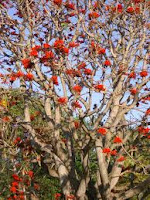The Indian coral tree is as its name suggests native to the Indian subcontinent, and its range extends throughout South-east Asia to Malaysia Africa . The Indian coral tree is a member of the Leguminoseae or Fabaceae family of plants making it a relative of dhak, the pongam tree, ashoka (Saraca indica),the monkey pod tree, jhand, lentils, indigo, the butterfly pea, chickpeas, soya beans and lupins to name but a few.
The tree is useful as a nitrogen fixer and helps poor soil increase its fertility. It is panted as an ornamental and a shade tree, and used for this last purpose in coffee and cacao plantations. It is also used as a trellis for vines and climbing plants and is used to support the betel nut (paan) vine, black pepper plants, as well as vanilla and yams.
 The bark of this tree is paper-thin and can be yellow through to brown, and the seed pods contain between five and twelve seeds. The tree can grow to around sixty feet although they rarely grow to heights of more than fifty feet (fifteen metres). Some people in
The bark of this tree is paper-thin and can be yellow through to brown, and the seed pods contain between five and twelve seeds. The tree can grow to around sixty feet although they rarely grow to heights of more than fifty feet (fifteen metres). Some people in  The bark and leaves of this tree are mainly the parts used in Ayurvedic medicine in the Indian subcontinent, with the juice from the leaves being put into ears to stop earache. The paste made from the tree parts is used for rheumatism and joint pains, applied to the affected areas, and it is also used for wounds as it has antiseptic properties, and for inflammation, including for eye problems. A powder is made to aid digestion, as an aphrodisiac and for erectile dysfunctions. It is also used to get rid of intestinal worms, for blood purification, to regulate menstruation, for infections of the urinary tract such as cystitis, obesity, fevers and externally for skin problems.
The bark and leaves of this tree are mainly the parts used in Ayurvedic medicine in the Indian subcontinent, with the juice from the leaves being put into ears to stop earache. The paste made from the tree parts is used for rheumatism and joint pains, applied to the affected areas, and it is also used for wounds as it has antiseptic properties, and for inflammation, including for eye problems. A powder is made to aid digestion, as an aphrodisiac and for erectile dysfunctions. It is also used to get rid of intestinal worms, for blood purification, to regulate menstruation, for infections of the urinary tract such as cystitis, obesity, fevers and externally for skin problems. It is believed to support the liver and nerves functions and is anti-inflammatory, analgesic (pain-relieving), and to dilate the blood vessels. An infusion of the bark and leaves is used for coughs as an expectorant. A preparation is also used for insomnia, to promote lactation in breast-feeding mothers, for lower back pain relief and knee pain as well as for rheumatism.
Clinical studies have found that the isoflavonoids present in this coral tree can help protect bone mass in mice and have anti-osteoporotic effects (2007, Zhang Y. et al. Journal of Ethnopharmacology, Vol.109 (1) pp 165-9). However these actions have not been tested on humans.
In a 2002 study conducted by Tanaka H. et al. the isoflavonoids were found to have antibacterial properties. More studies are underway to discover whether the traditional medicinal uses of this tree have scientific bases.





Like the Indian coral tree called parijat-according to indian mythology during the churning of the ocean-one of the things that came out among various other things.vinod
ReplyDelete